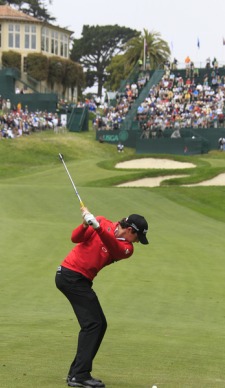Patience the key for Olympic test
 Rory McIlroy plays his second shot into the 18th at The Olympic Club (Photo Eoin Clarke/www.golffile.ie)Rory McIlroy got a B minus for his ceremonial pitch ahead of the baseball clash of the San Francisco Giants and the Houston Astros on Tuesday might.
Rory McIlroy plays his second shot into the 18th at The Olympic Club (Photo Eoin Clarke/www.golffile.ie)Rory McIlroy got a B minus for his ceremonial pitch ahead of the baseball clash of the San Francisco Giants and the Houston Astros on Tuesday might.
But whether he strikes out or hits a home run when he steps up to the plate in the US Open over the next few days will depend on one thing - his patience.
The 23-year old has proved to have a short fuse this year, famously hurling a club during the BMW PGA at Wentworth in the middle of a streak that saw him miss three cuts on the spin.
The world No 2 got his game back on track in Memphis last week but he knows he must not let the red mist descend like a San Francisco fog if he is to become the first man to retain the US Open for 23 years.
McIlroy confessed: “US Opens are all about patience and not letting bogeys or anything else get to you. Because you know everyone’s going to have them.
“Everyone’s going to have a few bad holes and it’s about how you deal with it and move on to the next.”
Set on a hillside overlooking Lake Merced, the Olympic Club’s sloping fairways are designed to kick balls into the rough. But that’s not the only aspect of the storied course that could drive Ireland’s quartet of challengers to distraction this week.
The greens are so firm that several chipping areas have been brought into play and two of them could cause carnage if the wind blows.
The 199-yard par three 13th features a swale left of the green that sweeps down to a dry lateral water hazard. Then there’s the right side of the par-five 17th, where a closely mown area will swallow anything hit right of the flag and feed it down to towards the 18th tee.
“You’ve got to concentrate over every shot here,” said McIlroy, who got to the course nearly a week ago after missing the cut in Memphis. “Coming back even since last week and obviously the greens now are a little firmer, they’re a little faster and it makes the greens seem a little more severe.
“So the likes of the 17th green, you get it anywhere right of that hole and it’s just going down that slope into that runoff area. The 13th with the green firmer, anything landing on the left side of that green is probably going to feed down that collection area, as well.
“You can look at every hole here and you can pick out something that’s tough about it. All 18 holes this week are going to be crucial.”
Peter Lawrie fears the four to six inch rough around the greens that makes pitching a lottery.
“Around the greens, it’ll be a little more difficult that I probably expected,” the Dubliner said. “There’s not too many runoffs around the greens. It’s more the case of playing tricky little pop-up shots out of that heavy grass – they’re difficult.”
Even the last two holes - a par-five and a 344-yard par four - can jump up and bite the best. They might be birdie holes, but disaster lurks.
“They’re some of the best holes that are on the golf course, because 17 now provides an opportunity for an eagle coming down, making a two shot swing,” Phil Mickelson said. “I’ve seen guys make 6’s and 7’s there.”
As for the 18th, which is a three iron and a wedge for most, Mickelson knows it will be pivotal
“Look what happened to Hogan,” he said recalling the Ice Man’s double double in 1955 that saw him end up in a play-off with Billy Casper, which he lost. “You think it’s a nothing hole, but you hook it in the rough and you make double and you lose the [US] Open.”